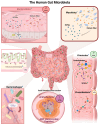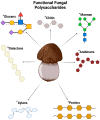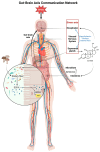Therapeutic Potential of Fungal Polysaccharides in Gut Microbiota Regulation: Implications for Diabetes, Neurodegeneration, and Oncology
- PMID: 38921380
- PMCID: PMC11204944
- DOI: 10.3390/jof10060394
Therapeutic Potential of Fungal Polysaccharides in Gut Microbiota Regulation: Implications for Diabetes, Neurodegeneration, and Oncology
Abstract
This review evaluates the therapeutic effects of polysaccharides derived from mushroom species that have medicinal and edible properties. The fungal polysaccharides were recently studied, focusing on their modulation of the gut microbiota and their impact on various diseases. The study covers both clinical and preclinical studies, detailing the results and highlighting the significant influence of these polysaccharides on gut microbiota modulation. It discusses the potential health benefits derived from incorporating these polysaccharides into the diet for managing chronic diseases such as diabetes, neurodegenerative disorders, and cancer. Furthermore, the review emphasizes the interaction between fungal polysaccharides and the gut microbiota, underscoring their role in modulating the gut microbial community. It presents a systematic analysis of the findings, demonstrating the substantial impact of fungal polysaccharides on gut microbiota composition and function, which may contribute to their therapeutic effects in various chronic conditions. We conclude that the modulation of the gut microbiota by these polysaccharides may play a crucial role in mediating their therapeutic effects, offering a promising avenue for further research and potential applications in disease prevention and treatment.
Keywords: cancer; diabetes; fungal polysaccharides; gut microbiota; health implications; natural compounds; neurodegenerative diseases.
Conflict of interest statement
The authors declare no conflicts of interest.
Figures




Similar articles
-
Health benefits of edible mushroom polysaccharides and associated gut microbiota regulation.Crit Rev Food Sci Nutr. 2022;62(24):6646-6663. doi: 10.1080/10408398.2021.1903385. Epub 2021 Apr 1. Crit Rev Food Sci Nutr. 2022. PMID: 33792430 Review.
-
The Interaction between Mushroom Polysaccharides and Gut Microbiota and Their Effect on Human Health: A Review.Biology (Basel). 2023 Jan 12;12(1):122. doi: 10.3390/biology12010122. Biology (Basel). 2023. PMID: 36671814 Free PMC article. Review.
-
The benefits of edible mushroom polysaccharides for health and their influence on gut microbiota: a review.Front Nutr. 2023 Jul 6;10:1213010. doi: 10.3389/fnut.2023.1213010. eCollection 2023. Front Nutr. 2023. PMID: 37485384 Free PMC article. Review.
-
Auricularia auricula-judae (Bull.) polysaccharides improve type 2 diabetes in HFD/STZ-induced mice by regulating the AKT/AMPK signaling pathways and the gut microbiota.J Food Sci. 2021 Dec;86(12):5479-5494. doi: 10.1111/1750-3841.15963. Epub 2021 Nov 17. J Food Sci. 2021. PMID: 34787328
-
The Impact of Mushroom Polysaccharides on Gut Microbiota and Its Beneficial Effects to Host: A Review.Carbohydr Polym. 2020 Dec 15;250:116942. doi: 10.1016/j.carbpol.2020.116942. Epub 2020 Aug 27. Carbohydr Polym. 2020. PMID: 33049854 Review.
Cited by
-
The Microbiota-Gut-Brain Axis and Neurological Disorders: A Comprehensive Review.Life (Basel). 2024 Sep 26;14(10):1234. doi: 10.3390/life14101234. Life (Basel). 2024. PMID: 39459534 Free PMC article. Review.
-
Chemical Composition, Antioxidant and Anti-Inflammatory Activity of Shiitake Mushrooms (Lentinus edodes).J Fungi (Basel). 2024 Aug 5;10(8):552. doi: 10.3390/jof10080552. J Fungi (Basel). 2024. PMID: 39194878 Free PMC article.
References
-
- Starwood J. Mushroom Wanderland: A Forager’s Guide to Finding, Identifying, and Using More Than 25 Wild Fungi. The Countryman Press; Woodstock, VT, USA: 2021.
-
- Yang L., Kang X., Dong W., Wang L., Liu S., Zhong X., Liu D. Prebiotic properties of Ganoderma lucidum polysaccharides with special enrichment of Bacteroides ovatus and B. uniformis in vitro. J. Funct. Foods. 2022;92:105069. doi: 10.1016/j.jff.2022.105069. - DOI
-
- Chen M., Xiao D., Liu W., Song Y., Zou B., Li L., Li P., Cai Y., Liu D., Liao Q., et al. Intake of Ganoderma lucidum polysaccharides reverses the disturbed gut microbiota and metabolism in type 2 diabetic rats. Int. J. Biol. Macromol. 2020;155:890–902. doi: 10.1016/j.ijbiomac.2019.11.047. - DOI - PubMed
-
- Guo C., Guo D., Fang L., Sang T., Wu J., Guo C., Wang Y., Wang Y., Chen C., Chen J., et al. Ganoderma lucidum polysaccharide modulates gut microbiota and immune cell function to inhibit inflammation and tumorigenesis in colon. Carbohydr. Polym. 2021;267:118231. doi: 10.1016/j.carbpol.2021.118231. - DOI - PubMed
-
- Chen W.-J., Wei Y.-S., Lo H.-I., Chu H.-F., Tseng M.-C., Lee B.-H., Shen T.-L. Liquid-State Fermented Ganoderma lucidum GANO99 Regulates Gut Microbiota and Concomitantly Modulates the Behavioral Deficits and Neurohistopathological Hallmarks of Alzheimer’s Disease in a Preclinical Transgenic Mouse Model of Alzheimer’s Disease. J. Food Biochem. 2024;2024:6676977. doi: 10.1155/2024/6676977. - DOI
Publication types
Grants and funding
LinkOut - more resources
Full Text Sources

